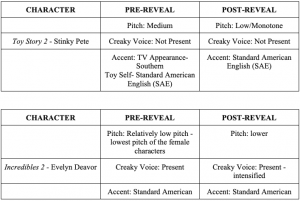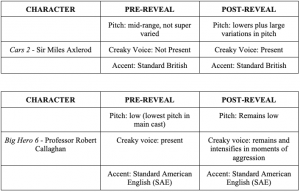Wendy Barenque, Maria Martignano Cassol, Kelli Sakaguchi, Sophia Siqueiros, Ellis Song
Every year Disney and Pixar release blockbuster hits watched by millions of children. Disney and Pixar characters have a huge impact on how children learn to view people in real life through the use of regional and foreign accents categorizing intrinsic “goodness” or “badness” (Lippi-Green, 2012). Recently, there has been a rising trend in the usage of “switch characters” in the Disney and Pixar cinematic universe. “Switch characters” are characters who are able to fake membership in the “good” character category and later reveal to not belong to this category. In this research, accent along with other linguistic variables such as pitch and creaky voice were tracked to determine if correlations exist between these linguistic variables and “switch characters” portrayals of “goodness” and “badness.” Does a “switch character” use a linguistic variable differently when portraying themselves as good rather than bad? For example, if linguistics changes do occur, do audiences begin to associate a certain pitch, accent, or creaky voice with “good” or “bad” categories of people? Specifically, we examined how the language aspects of “switch characters” changed between pre- and post- revelation scenes in nine Disney and Pixar films such as Frozen and Zootopia. Ultimately, we found a linguistic trend that may affect the audience’s perspective on movie characters. Keep on reading to see the effects these movies may unconsciously have on your associations of “good” and “bad” people!
In this project, we examined the correlation between linguistic features and a character’s group membership (as good or bad) in Disney and Pixar films. The specific characters we looked into are those we call “switch characters.” “Switch characters” are those that fake membership as one of the “good guys” but are later revealed as villains. The three linguistic features we felt were most important consisted of pitch, creaky voice, and accent.
Some important definitions:
Pitch: how high or low the speaker’s voice is.
Creaky Voice: also known as vocal fry, happens when the speaker drops their voice to their lowest natural register for emphasis.
Accent: pronunciation specific to an individual or location.
We predicted there would be a change in one or more of these features when a “switch character’s” true membership was revealed. For pitch, we compared range (high, medium, low) of the “switch characters” before and after their reveal to determine if there is a trend in pitch change in a certain direction. Similarly, we looked at the presence of creaky voice preceding and following the switch. In analyzing accents, we aimed to identify any kind of change the character’s pronunciation may undergo.
Our analysis studied the use of linguistic profiling (being able to identify social characteristics based on the language used by the speaker) used by movie makers to reinforce the goodness or badness of a character. We presumed speaker agency in pitch, creaky voice, and accent, through the lens of Speaker and Audience Design Models (Bell, 1984, p. 158). This means that we assumed that “switch characters” actively shift their language based on what group they identify with to distance themselves from or bring themselves closer to their audience.
We based our project on Lippi-Green’s (2012) research that revealed a correlation between accents and variations of standard English with villains. We expanded on her project by looking at additional linguistic variables in Disney and Pixar movies made after 1995 which we believe better represent modern society. The nine movies and characters we analyzed are Frozen (Prince Hans), Coco (Ernesto de La Cruz), Big Hero 6 (Professor Callaghan), Toy Story 3 (Lotso), The Incredibles 2 (Evelyn Deavor), Monsters Inc. (Mr. Waternoose), Toy Story 2 (Stinky Pete), Cars 2 (Sir Miles Axlerod), and Zootopia (Dawn Bellweather).
Methodology: A Sneak Peek into Film Analysis
Here is an example from Toy Story 3. This example is representative of the methodology that the group utilized to accurately label all nine “switch characters” – pitch, creaky voice, and accent. For the purpose of data collection, a chart adapted from Soares (2017) was used to organize and uniformize character analysis. We repeated the process with all nine films and compiled the analysis into graphs included below.
This selected scene features an exchange between the hero Buzz and the villain Lotso. At the beginning of this scene, Buzz is unaware that Losto is a villain. We see Buzz requesting a group transfer to the Butterfly playroom. Things take a turn for the worse, however, as Lotso only agrees to let Buzz transfer playrooms. Click on the link to see what happens next!
Focusing on “pitch,” the group found uptalk in phrases such as, “showed initiative” and “we got a keeper.” Uptalk is a manner of speaking with a rising intonation at the end of sentences. The italics represent Lotso’s rising intonation. After Lotso’s villainous nature is revealed, uptalk disappears and we hear a deepening and leveling of pitch. Phrases such as, “family man” and “back in the timeout chair” exemplify this deepening and leveling. Therefore, the group labeled Lotso’s pre-reveal pitch as “high: (uptalk)” and post-reveal as “low/monotone.”
Focusing on “creaky voice,” the group didn’t find any phrases that employed a rough voice quality and a lowered pitch. Therefore, the group labeled Lotso’s pre-reveal and post-reveal “Creaky Voice” as “Not Present.”
Focusing on “accent,” the group agreed that Lotso’s phrases possessed the slurred speech patterns of a Southern American accent. Lotso’s Southern accent was exemplified in words containing “r’s” such as ”caterpillar.” Therefore, the group labeled Lotso’s pre-reveal and post-reveal accent as “Southern.”
Results
We noted that eight characters changed at least one linguistic element (pitch, creaky voice, or accent) after their reveal. Our prediction based on Lippi-Green’s analysis proved true, language aspects in the Disney universe do correlate to a character’s identity as good or bad.




Charts 1-9. Linguistic Analysis of Disney and Pixar “Switch Characters” Comparison of pitch, creaky voice and accent pre-reveal and post-reveal.
The linguistic aspect that changed most was pitch, followed by creaky voice and accent. Only one character, Stinky Pete, had an accent change, settling completely into Standard American English (SAE) after the reveal as opposed to switching between Southern American and SAE. Considering that Stinky Pete employed SAE before revealing himself as a villain, we decided to view accent as not indexing goodness or badness in his character. This diverges from our initial prediction, since Lippi-Green’s study demonstrated a strong relationship between accent and intrinsic goodness and badness.

After determining which aspects changed after the reveal (pitch and creaky voice) we analyzed exactly how these aspects changed. For eight of the nine characters, there was a drop in pitch, and only one character had a rise in pitch. It is also worth noting that some of the characters’s pitch dropped when they produced especially aggressive statements or when they mocked their villainous persona. From our data, we conclude that a strong correlation exists between lower pitch and evil personas.

The other linguistic aspect we noticed a change in was creaky voice. Six characters used creaky voice after their reveal. Of the characters that initially presented creaky voice all maintained creaky voice after reveal. One thing to note is that creaky voice is closely related to pitch, therefore a drop in pitch normally meant the addition of creaky voice.

Overall, our data supports the hypothesis that certain linguistic aspects correlate with group membership (as good or bad). However, this change seems to be mostly related to pitch and not accents as studied by Lippi-Green (2012). Drop in pitch seems to be the universal linguistic aspect in Disney and Pixar’s universe that signifies a villainous persona and a higher pitch seems to signify and contribute to blending in with good characters.
Discussion
We know that Disney and Pixar movies have helped to socialize children into stereotyping and othering, based on accents in the research done by Lippi-Green (2012) and others. But do “switch characters” also contribute to this categorization in children? Through this study, we conclude that pitch, as well as the presence of creaky voice, are heavily correlated to an evil persona. So do children begin to associate these features with villains after seeing such movies?
Children tend to relate a higher pitch to brightness (Marks, Hammeal, Bornstein, 1987). This association creates a positive attitude towards a higher pitch, as shown by Banaji and Greenwald in “Into the Blindspot.” Therefore a lower pitch may imply a more negative attitude towards the person speaking. This could imply that children are wary of those with lower pitches in their speech and so, when the “switch characters” do this, it only reinforces this association.
There aren’t enough studies on children’s perception of creaky voice to conclude its influence on them. But if lower pitch implies a negative attitude, then the lowest register (creaky voice) will most likely imply one as well.
As a result, we can theorize that children notice and are affected by the changes in pitch and the use of creaky voice. However, our conclusions on the effect of the movies on the audience can only be hypothetical, as our data does not include audience responses.
Conclusion
In our study we analyzed how certain linguistic features (pitch, creaky voice, and accent) changed when a character switched from good to bad. The purpose of our study was to find linguistic trends in these characters.
Our data showed that most “switch characters” dropped pitch and added creaky voice when they revealed to be evil, while their accent remained constant. Looking at Marks, Hammeal and Bornstein (1987), we found that children are likely to view a higher pitch positively and theorized that Disney and Pixar movies might contribute to this phenomenon, or, at the very least, rely on it for indicating a character’s identity as good or bad.
However, we can’t make definite conclusions because our small sample size and lack of data of the audience’s response. So, we can only theorize what kind of impact these “switch characters” have on their audience and what linguistic trends are present in the Disney universe. But linguistic trends in Disney characters remains an important topic to be researched, because of the continued promotion of the dominant ideology presented in Disney and Pixar movies, especially considering the size of their audience.
References
Banaji, M., & Greenwald, A. (2013). Blindspot: Hidden biases of good people. New York: Delacorte Press.
Bell, A. (1984). Language Style as Audience Design. Language in Society, 13 ( 2), 145-204. Retrieved from https://www.jstor.org/stable/4167516?seq=10#metadata_info_tab_contents
Girard, F., Floccia, C., & Goslin, J. (2008). Perception and awareness of accents in young children. British Journal of Developmental Psychology, 26(3), 409-433.
Lippi-Green, R. (2012). Teaching Children how to discriminate: What we learn from the Big Bad Wolf. English with an Accent: Language, Ideology and Discrimination in the United States, 7, 101-129.
Marks, L. E., Hammeal, R. J., & Bornstein, M. H. (1987). Perceiving Similarity and Comprehending Metaphor. Monographs of the Society for Research in Child Development, 52(1),1-92.
Soares, Telma O. (2017). Animated Films and Linguistic Stereotypes: A Critical Discourse Analysis of Accent Use in Disney Animated Films. Bridgewater State University Master Theses and Projects. 53, 1-53.